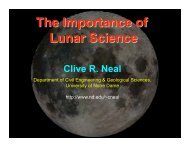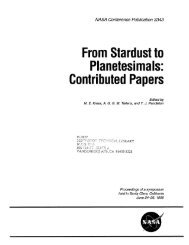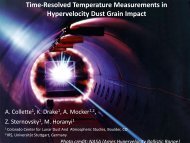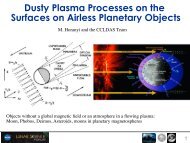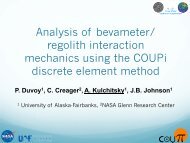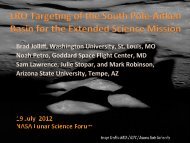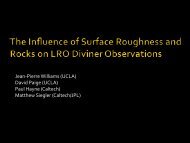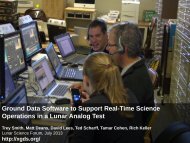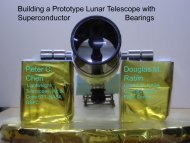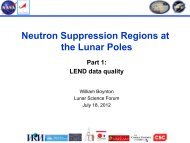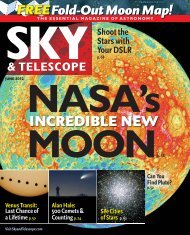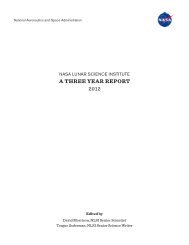PI: Ben Bussey (JHU/APL) - NASA Lunar Science Institute
PI: Ben Bussey (JHU/APL) - NASA Lunar Science Institute
PI: Ben Bussey (JHU/APL) - NASA Lunar Science Institute
Create successful ePaper yourself
Turn your PDF publications into a flip-book with our unique Google optimized e-Paper software.
National Aeronautics and Space Administration<br />
YEARS 1-3 EXECUTIVE SUMMARY<br />
Scientific and Exploration<br />
Potential of the <strong>Lunar</strong> Poles<br />
<strong>PI</strong>: <strong>Ben</strong> <strong>Bussey</strong> (<strong>JHU</strong>/<strong>APL</strong>)
Scientific and Exploration Potential of the <strong>Lunar</strong> Poles Executive Summary<br />
<strong>PI</strong>: <strong>Ben</strong> <strong>Bussey</strong> (<strong>JHU</strong>/<strong>APL</strong>) ben.bussey@jhuapl.edu<br />
When we began this integrated research project, the lunar polar regions were regarded<br />
as “Luna incognita”, the unknown Moon. During the last three years we have striven to<br />
further our understanding of the polar regions so that they are now as well known, and in<br />
some case better known, than the rest of the Moon. ”Luna incognita” has become “luna<br />
cognita”.<br />
The goal of our team was to<br />
advance our scientific understanding<br />
of the Moon’s poles<br />
and to fill in strategic knowledge<br />
gaps that facilitate the robotic<br />
and human exploration of<br />
these areas. One aspect that<br />
could not have been predicted<br />
Characterizing Luna Incognita:<br />
• Study the geology of the poles<br />
• Characterize the surface and subsurface<br />
properties<br />
• Evaluate the ability to conduct surface operations,<br />
regolith excavation, and drilling<br />
• Evaluate potential instrumentation for science<br />
conducted from and on the Moon<br />
is the wealth of new data that have become available since we began. These new data<br />
produced by an armada of spacecraft, including India’s Chandrayaan-1 and Japan’s<br />
Kaguya mission, provide new insight into the processes and history of the lunar poles.<br />
A key aspect of our research has been collaboration. In addition to the natural collaboration<br />
between team members our work has benefited by the successful collaboration<br />
with other NLSI teams as well as other US and international scientists and engineers.<br />
Our research has addressed several high priority science concepts from the SCEM report;<br />
“The lunar poles are special environments that may bear witness to the volatile flux<br />
over the latter part of solar system history”, “The bombardment history of the inner solar<br />
system is uniquely revealed on the Moon”, “The Moon is an accessible laboratory for<br />
studying the impact process on planetary scales”, “Key planetary processes are manifested<br />
in the diversity of lunar crustal rocks”, and “The Moon is a natural laboratory for<br />
regolith processes and weathering on anhydrous airless bodies”. Additionally our work<br />
supports the goals of the Planetary Decadal Survey “What are the compositions, distributions,<br />
and sources of planetary polar deposits?”<br />
Our research has been divided into three themes: (1) <strong>Lunar</strong> Polar Environment, (2) Surface<br />
Characterization, and (3) Surface <strong>Science</strong>, Instrumentation, and Operations. By design,<br />
there is substantial overlap across topics, with each providing information to the<br />
others to facilitate a deeper, more thorough understanding of the questions that are posed.
<strong>Lunar</strong> Polar Environment: This theme includes: geology, illumination, volatile trans-<br />
port modeling, volatile-regolith<br />
laboratory studies.<br />
Polar Geology: We have conducted<br />
several studies designed to<br />
elucidate the geological histories,<br />
nature and origin of the polar deposits.<br />
Using new spacecraft opti-<br />
cal and radar images and Earth-based radar images, we have re-investigated and mapped<br />
the geology of the south pole, including a determination of the relative age of Shackleton<br />
crater. Shackleton was found to be more heavily cratered (older) than the mare surface at<br />
Apollo 15 (3.3 Ga), but less cratered (younger) than the Apollo 14 site (3.85 Ga). These<br />
data indicate that Shackleton is older than originally thought (Imbrian age) and may have<br />
collected extra-lunar volatile elements for at least the last 2 billion years. Such a history<br />
makes this crater an attractive site for exploration and possible human presence.<br />
Polarimetric radar data acquired with the Mini-RF instruments indicate that ice may be<br />
abundant in the polar regions. Some craters show elevated CPR only in their interiors;<br />
over 40 of these anomalous craters have been identified. The radar signature is consistent<br />
with the presence of ice deposits in the interior of these craters. Almost all are in permanent<br />
sun shadow and correlate with proposed locations of polar ice modeled on the basis<br />
of <strong>Lunar</strong> Prospector neutron data.<br />
In response to the assertion by the Augustine Commission that a return to the Moon is<br />
unaffordable, we investigated a possible architecture that extends human reach beyond<br />
low Earth orbit by creating a permanent space transportation system with reusable and<br />
refuelable vehicles. Such a system<br />
is made possible by establishing a<br />
robotic outpost on the Moon that<br />
harvests water and produces propellant<br />
from the ice deposits of the<br />
permanently dark areas. This outpost<br />
can be established under existing<br />
and projected budgetary limitations<br />
within 16 years of program<br />
start.<br />
We have remapped the polar geology<br />
<strong>Lunar</strong> Polar Environment:<br />
• Study the geology of the lunar poles<br />
• Characterize the polar illumination conditions<br />
• Migration, sequestration and stability of polar<br />
volatiles<br />
• Mechanisms of volatile storage<br />
Polar Illumination: The availability<br />
of high-resolution topography,<br />
combined with a high-fidelity simulation tool has allowed polar illumination conditions<br />
to be well characterized, including the ability to determine data useful for planning future<br />
lander missions. We have developed a simulation tool called <strong>Lunar</strong>Shader that uses topography<br />
data and a user-selected Sun position to precisely determine which areas of the<br />
lunar surface are illuminated. Our first milestone was a comparison of Clementine images<br />
with simulations using Kaguya’s laser-derived topography data. Comparison between our<br />
simulations and the actual images revealed a very good match. Now that we have validated<br />
the results from the simulation tool we were able to map the illumination conditions
at both poles, determining which areas receive the most sunlight, as well as mapping the<br />
areas of permanent shadow that never see the Sun. We have continued to improve our<br />
knowledge of these areas by using the higher spatial resolution products that have been<br />
released be LRO’s LOLA team. As the spatial resolution improves, we find that the areas<br />
that receive the most illumination get smaller. We are excited by future collaboration<br />
with the LROC team, combining our tool with their NAC high-resolution analyses.<br />
Part of our research has considered the affect of placing solar arrays on different mast<br />
heights. We have found that even engineering feasible mast heights of a few meters can<br />
result in increased Sun visibility compared with the surface illumination.<br />
Polar Volatiles: Since our team was established, volatiles in polar regions have been definitively<br />
detected. Our research has analyzed data regarding lunar volatiles and conducted<br />
modeling to support interpretation of the volatile data. This work includes atmospheric<br />
modeling to consider volatile transport and space weathering to follow volatile retention.<br />
distance (km)<br />
-1600<br />
-1800<br />
-2000<br />
-2200<br />
-2400<br />
-1800<br />
-1600<br />
-2000<br />
-2200<br />
-2400<br />
-1600<br />
-1800<br />
-2000<br />
-2200<br />
-2400<br />
H<br />
H 2<br />
O<br />
t=45 s<br />
-1600<br />
-1800<br />
-2000<br />
-2200<br />
-2400<br />
OH<br />
-1000 -500 0 500 1000<br />
distance (km)<br />
column<br />
density<br />
(#/cm 2 /kg H 2 O)<br />
Modeled photodissociated products of<br />
water in the LCROSS plume<br />
10 10<br />
10 9<br />
10 8<br />
10 7<br />
10 6<br />
10 5<br />
The impact of the <strong>Lunar</strong> Crater Observation<br />
and Sensing Satellite (LCROSS) into the<br />
crater Cabeus released water and other<br />
volatiles into the space, where they were<br />
observed by LRO, LCROSS, HST, and<br />
ground-based telescopes. We modeled the<br />
propagation of the vapor release and<br />
compared that to the observed light-curves for<br />
H2O, OH, H, O, Na, H2, CO, Mg, Ca, and Hg.<br />
For selected species, we determined the<br />
timing, temperature, bulk velocity, mass, and<br />
regolith abundance of the species. This study<br />
was not included in the original proposal; but<br />
arose from the interactions among our NLSI<br />
team members and the NSLI DREAM team<br />
after the success of the LCROSS experiment.<br />
We used two-dimensional modeling of space<br />
weathering processes on the Moon to provide<br />
a framework for interpreting spacecraft data<br />
regarding polar volatiles. We have simulated<br />
the evolution of an ice layer over time and compared the model results as they would be<br />
observed in neutrons, FUV, radar, and in situ. This work enables a self-consistent interpretation<br />
of the seemingly disparate data on the distribution and abundance of volatiles in<br />
lunar polar regions coming from LRO, LCROSS, and Chandrayaan-1.<br />
Volatile-Regolith Modeling: Our team is conducting laboratory and modeling experiments<br />
to better characterize and understand the nature and evolution of H2O, hydroxyl,<br />
and other volatiles potentially at the poles. We are conducting Temperature Programed<br />
Desorption measurements on lunar analog materials to determine the thermal stability of<br />
both molecular water and hydroxyl on the surface. We also characterize these adsorbed<br />
species with UV through IR reflectance measurements under appropriate pressure and<br />
temperatures.
We have identified a compositional dependence in the thermal stability of water on lunar<br />
analog materials, when that data is coupled to our models of water evolution, it affects<br />
our prediction of the distribution of water (and hydroxyl) on the Moon. Additionally,<br />
by experimentally and theoretically investigating the stability, formation, and loss of<br />
water and hydroxyl, we can understand better if/how solar wind may form hydroxyl and<br />
how this hydroxyl may evolve to form water. Our experiments to determine the spectral<br />
nature of adsorbed water and hydroxyl enable us to assign the infrared absorption bands<br />
observed on the Moon to water or hydroxyl, thus providing insight into the origin and<br />
nature of these materials.<br />
Surface Characterization: We have been using the latest data to study lunar surface<br />
characteristics. We have determined that self-secondary cratering on the continuous<br />
ejecta is a significant factor during an impact event. Such self-secondary craters are in<br />
part buried by melt and bouldery ejecta facies indicating that they formed concurrently<br />
with ejecta emplacement. Since the lunar chronology is tied to the crater frequencies of<br />
the Copernicus and Tycho ejecta blankets, if those frequencies do not represent the impact<br />
flux, the chronology will be incorrect.<br />
We have also discovered that impact melt can occur in simple highlands craters down<br />
to diameters as small as 170 m. These craters have been interpreted as due to vertical impacts<br />
wherein maximum shock and heating occur (compared with more oblique impacts).<br />
As vertical impacts are relatively rare, so are such small craters with impact melt.<br />
We have been examining the mineralogical composition and thermal history of lowcalcium<br />
pyroxenes excavated from deep within the lunar crust. The composition and<br />
stratigraphy of these rocks provides key constraints on the nature and evolution of the<br />
lunar magma ocean. We have also been mapping the distribution of hydroxyl absorptions<br />
across the Moon, likely produced by solar wind bombardment of the lunar regolith. The<br />
OH - production hypothesis is being tested by characterizing the volatile distribution on<br />
localized scales at different times<br />
in the <strong>Lunar</strong> day, to evaluate<br />
whether it is transient or stably distributed.<br />
Surface <strong>Science</strong>, Instrumentation,<br />
and Operations: This theme<br />
consisted of diverse objectives<br />
Surface <strong>Science</strong>, Instrumentation & Operations:<br />
• Mobility & Excavation Studies<br />
• Use of Ground Penetrating Radar<br />
• Neutron Studies<br />
• Earth Observation<br />
with the common thread that they either uniquely use the lunar poles and/or are enabled<br />
by a lunar polar location.<br />
Excavation & Mobility Modeling: The goal is to develop physically based discrete element<br />
method (DEM) models of excavation and mobility problems on the Moon. The effects<br />
of different gravity, soil types and physical processes on the Moon, asteroids, and<br />
other planets make it impossible to accurately predict machine performance from Earthbased<br />
tests alone. We have: (1) conducted physical testing of wheel digging, static and<br />
percussive excavation, penetration, and geotechnical tri-axial strength tests on lunar<br />
simulants (primarily JSC-1a); (2) developed DEM model capabilities; (3) validated<br />
model capabilities by simulating physical tests using the models. Our most significant<br />
achievement is the development and validation of a physical DEM and distribution of its
eta version to Glenn Research Center and CRREL for testing and use in simulating<br />
physical tests. While the DEM was developed for excavation and mobility applications,<br />
its design is sufficiently general that it can be applied to other important lunar and small<br />
body problems, such as volatile migration in lunar regolith, and asteroid properties. Other<br />
accomplishments include developing extensive physical test data related to excavation<br />
and mobility and lunar simulant mechanical<br />
properties.<br />
We compare physical testing with modeling<br />
results.<br />
Ground Penetrating Radar: Ground-<br />
Penetrating Radar (GPR) data from terrestrial<br />
analog environments can help constrain models<br />
of the evolution of the lunar surface, help<br />
predict the nature of subsurface properties,<br />
and aid in interpretation of orbital SAR data.<br />
GPR data from terrestrial settings can constrain<br />
the range of expected radar properties<br />
associated with varying substrates, thereby<br />
providing a tool for predicting the physical<br />
properties, clast-size distribution, and layering<br />
of the lunar subsurface. The goal of our work has been to demonstrate the capabilities of<br />
GPR in defining the range of radar properties at terrestrial sites where geologic processes,<br />
settings, and/or materials may be similar to those encountered on the MoonFieldwork has<br />
been conducted at five planetary analogue sites; Meteor Crater, Sunset Crater and SP<br />
Cone cones and lavas, the Columbia River Plateau basalts, and multiple locations on the<br />
Big Island of Hawaii.<br />
By comparing analysis of GPR with the known local stratigraphy, we have shown that<br />
GPR can be used to probe the subsurface and help constrain the physical properties and<br />
setting of near surface materials. Our work highlights the utility and portability of using<br />
such a GPR during future exploration on the lunar surface to map geologic environments<br />
and target locations for sampling and suitable for eventual human exploration.<br />
Neutron Studies: We have focused on: 1) Determining the feasibility for making high<br />
spatial resolution neutron measurements on the surface; and 2) Carrying out neutron<br />
transport modeling and data analysis to test ideas about measuring lunar hydrogen abundances.<br />
We studied the design of a surface high-resolution neutron imager using two different<br />
technologies, collimated and grazing incidence. Our analysis shows that a collimated<br />
instrument is required to collect such measurements.<br />
Recent spectral data have shown the presence of surficial water over large expanses of<br />
the lunar surface. These results have led to a reexamination of the hydrogen abundance<br />
sensitivity limits of orbital neutron data. A wet-over-dry, two-layer stratigraphy has been<br />
modeled for the first time using neutron transport codes. Application of this effort to<br />
Goldschmidt crater reveals that it may have an enhanced hydrogen content of 0.1-1% water<br />
equivalent hydrogen. We have also studied data from the <strong>Lunar</strong> Exploration Neutron<br />
Detector (LEND) in order to better understand how these data provide information of lunar<br />
surface hydrogen abundances. We have confirmed that the LEND instrument is sensitive<br />
to lunar surface compositional variations from both the collimated and uncollimated<br />
sensors.
Earth Observation: Our goal is to examine the potential for a long-term full-disk Earth<br />
observing instrument on the Moon. The intent is to develop an instrument concept to<br />
characterize the remotely detectable physical and biological signatures of the Earth as a<br />
function of time. A lunar polar vantage point is unique, making it possible to track Earth's<br />
ever-changing photometric, spectral and polarimetric signatures in a manner analogous to<br />
future observations of terrestrial planets orbiting<br />
other stars.<br />
Comparison between LCROSS observations<br />
and model results<br />
The work includes: the appearance and spectroscopic<br />
signatures and polarizations of the<br />
Earth and the strength of circular polarization<br />
signatures from biological material. Though<br />
not part of the original proposal, we fostered a<br />
collaboration with the LCROSS team to utilize<br />
their spectroscopy and imaging (UV to<br />
mid-IR) of the Earth at three very different<br />
orientations and phases. Sophisticated and detailed models have been produced by the<br />
<strong>NASA</strong> Astrobiology <strong>Institute</strong> Virtual Planetary laboratory for the Earth covering the<br />
three LCROSS Earth observing epochs. We find a good correlation between the actual<br />
and modeled results.<br />
Education & Public Outreach: Conveying the excitement of studying the Moon to the<br />
general public is an important aspect of our work. The EPO effort for our NLSI team<br />
continued to promote lunar science education through formal education and public outreach<br />
activities. Formal education activities included middle and high school educator<br />
professional development and a higher education lecture series. For Public Outreach,<br />
NLSI collaborated with the Maryland <strong>Science</strong> Center to host an event for International<br />
Observe the Moon Night. Also we maintain a website that reviews current lunar research<br />
done by NLSI and video archives of NLSI lecturers (http://lunarpoles.jhuapl.edu/).<br />
The “Unknown Moon <strong>Institute</strong>” workshops are a professional development opportunity<br />
for middle and high school educators from around the country. During this five day<br />
workshop, teachers receive in-depth content and participated in rich inquiry-based activities<br />
about lunar science. As part of our EPO effort we have developed a <strong>Lunar</strong> Geology<br />
Map lesson (that has passed SMD Product Review) that presents a discussion of types of<br />
geologic features found on the Moon.



